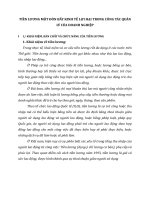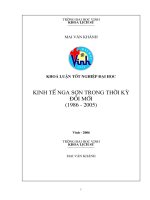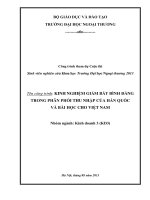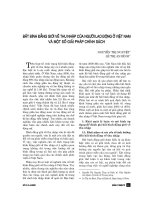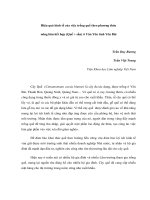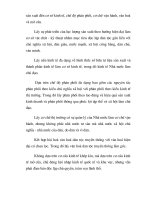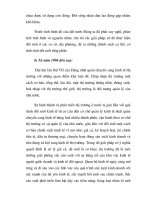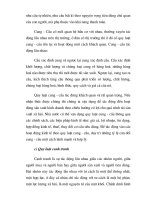Kinh tế ngầm trong mối quan hệ với FDI, chất lượng thể chế và bất bình đẳng thu nhập Bằng chứng thực nghiệm từ các nước châu Á (Luận án tiến sĩ)
Bạn đang xem bản rút gọn của tài liệu. Xem và tải ngay bản đầy đủ của tài liệu tại đây (1003.74 KB, 189 trang )
MINISTRY OF EDUCATION AND TRAINING
UNIVERSITY OF ECONOMICS HO CHI MINH CITY
HUYNH CONG MINH
SHADOW ECONOMY IN THE RELATIONSHIP WITH FDI,
INSTITUTIONAL QUALITY, AND INCOME INEQUALITY:
EMPIRICAL EVIDENCE FROM ASIAN COUNTRIES
PhD THESIS
Ho Chi Minh City – 2018
MINISTRY OF EDUCATION AND TRAINING
UNIVERSITY OF ECONOMICS HO CHI MINH CITY
HUYNH CONG MINH
SHADOW ECONOMY IN THE RELATIONSHIP WITH FDI,
INSTITUTIONAL QUALITY, AND INCOME INEQUALITY:
EMPIRICAL EVIDENCE FROM ASIAN COUNTRIES
Major:
Development Economics
Code:
9310105
PhD THESIS
Advisors:
1. Dr. Nguyen Hoang Bao
2. Dr. Nguyen Vu Hong Thai
Ho Chi Minh City – 2018
i
This thesis submitted to the School of Economics, University of Economics Ho Chi
Minh City, in partial fulfillment of the requirements for the degree of Doctor of
Philosophy in development economics.
ii
DECLARATION
I hereby declare that this thesis is my own research. Data and results are reliable,
clearly originated, and have never been published in any other study.
The author
iii
ACKNOWLEDGEMENTS
First of all, I would like to express my great gratitude to Dr. Nguyen Hoang Bao
and Dr. Nguyen Vu Hong Thai for their invaluable supervision and inspirations. Thank
you so much for keeping me on track throughout the research process, giving wise
comments, advices and encouragement during such a long academic journey.
Then I am honestly grateful to Dr. Pham Khanh Nam, Dr. Truong Dang Thuy,
Dr. Le Van Chon, Dr. Vo Tat Thang, Dr. Vo Hong Duc, Associate Pro. Dr. Nguyen
Huu Dung, Dr. Nguyen Luu Bao Doan, Dr. Pham Thi Thu Tra, Dr. Pham Thi Bich
Ngoc, Associate Pro. Dr. Vuong Duc Hoang Quan and the two independent Reviewers
for their valuable comments and encouragements so that I can improve the quality of
my thesis.
I cannot forget showing my special thanks to lecturers at school of economics as
well as those at University of Economics HCMC such as Professor Dr. Nguyen Trong
Hoai, Dr. Pham Khanh Nam, Dr. Truong Dang Thuy, Associate Pro. Dr.Nguyen Manh
Hung, Dr. Tran Thi Tuan Anh, Associate Pro. Dr. Tran Tien Khai… for their academic
and practical instructions during my time of study and research at the university.
Last but not least, I am deeply grateful to my beloved family, including my
deceased father, my 83-year-old mother as well as my sisters and brothers who always
support and encourage me in time for completing the thesis.
iv
TABLE OF CONTENTS
Declaration
Acknowledgements
Table of contents
List of Abbreviations
List of Tables
List of Figures
Pages
Chapter 1: Introduction ................................................................................................
1
1.1. Research context and gaps ........................................................................
1
1.2. Research objectives ...................................................................................
13
1.3. Research questions……………………………………………….. ..........
13
1.4. Research subjects and scope .....................................................................
13
1.5. Research methodology and data ………………………………… ...........
14
1.6. Contributions .............................................................................................
15
1.7. Limitations ................................................................................................
17
1.8. Thesis outline ............................................................................................
18
Chapter 2: Literature review and hypotheses ...............................................................
19
2.1. Shadow economy ......................................................................................
20
2.1.1. Theories on shadow economy ..........................................................
20
2.1.1.1. Definition ..................................................................................
20
2.1.1.2. Schools of thought .....................................................................
21
2.1.2. Empirical studies on shadow economy .............................................
31
2.1.2.1. Methods to estimate the size of the shadow economy ..............
31
v
2.1.2.2. Determinants (causes) ...............................................................
35
2.1.2.3. The impacts of shadow economy (effects) ................................
40
2.2. Shadow economy, FDI and Institutional quality ....................................
44
2.2.1. FDI and institutional quality .............................................................
44
2.2.1.1. Theories on FDI (Definition, Theories, Determinants) .............
44
2.2.1.2. Theories of institutional quality (Definition, Theories, Determinants) 47
2.2.1.3. The relationship between institutional quality and FDI ............
48
2.2.2. Institutional quality and shadow economy .......................................
54
2.2.2.1 The effect of institutional quality on shadow economy ...........
55
2.2.2.2 The effect of shadow economy on institutional quality ............
57
2.2.3. Shadow economy and FDI ...............................................................
59
2.2.3.1 The effects of FDI and FDI-institutional quality interaction on shadow
economy ...........................................................................................................
59
2.2.3.2 The effects of shadow economy on FDI ....................................
59
2.3. Shadow economy and income inequality ................................................
61
2.3.1. Income inequality ..............................................................................
61
2.3.1.1. Definition ..................................................................................
61
2.3.1.2. Theories ....................................................................................
62
2.3.1.3. Measurements............................................................................
65
2.3.1.4. Determinants .............................................................................
66
2.3.2. The impact of shadow economy on income inequality ......................
67
Chapter 3: Methodology, model specifications, and data ...........................................
73
3.1. Analytical framework ................................................................................
74
3.2. Empirical models and data ........................................................................
77
3.3. Econometric methodology ........................................................................
88
3.4. The sample selection of 19 Asian countries and their backgrounds on research
problems ...........................................................................................................
93
vi
Chapter 4: Shadow economy, FDI and Institutional quality: empirical evidence from Asian
countries ..........................................................................................................
96
4.1. Introduction ...............................................................................................
96
4.2. Data analysis..............................................................................................
97
4.2.1. Data descriptive statistics ..................................................................
97
4.2.2. Unit-root test......................................................................................
99
4.2.3. Correlation analysis ...........................................................................
101
4.3. Estimation results and discussions ...........................................................
102
Chapter 5: The impacts of shadow economy on income inequality in developing Asia
..........................................................................................................................
113
5.1. Introduction ...............................................................................................
113
5.2. Data descriptive statistics ..........................................................................
116
5.3. Empirical results and discussions ..............................................................
119
Chapter 6: Conclusions and policy implications ..........................................................
125
6.1. Conclusions ..............................................................................................
125
6.2. Policy implications ....................................................................................
128
6.3. Limitations and further research implications ...........................................
129
List of publications ............................................................................................................
130
References ...........................................................................................................................
131
Appendices ..........................................................................................................................
158
vii
LIST OF ABBREVIATIONS
2SLS:
Two-stage Least Squares
3SLS:
Three-stage Least Squares
ARDL:
Autoregressive-distributed lag model
AR1:
First-order Autocorrelation
AR2:
Second-order Autocorrelation
ECM:
Error correction model
EFR:
Economic Freedom Report
FDI:
Foreign direct investment
FE:
Fixed Effects
FH:
The Freedom House
GCI:
Global Competitiveness Index
GDP:
Gross Domestic Products
GLS:
Generalized Least Squares
GNI:
Gross National Income
MENA:
Middle East and North Africa
MIMIC:
Multiple Indicators Multiple Causes
MNCs:
Multinational Corporations
HDR:
Human Development Report
HF:
The Heritage Foundation
ICRG:
The International Country Risk Guide
IEF:
Index of Economic Freedom
viii
ILO:
International Labor Organization
IMF:
International Monetary Fund
IQ:
Institutional quality
JGLS:
Joint Generalized Least Squares
OLI:
Ownership, Location, and Internalization
OLS:
Ordinary Least Squares
POLS:
Pooled Ordinary Least Squares
PRS:
Political Risk Services Group
RE:
Random Effects
SEM:
Simultaneous equation model
SGMM:
Two Steps System Generalized Method of Moments
SURE:
Seemingly Unrelated Regression
UNESCO:
United Nations Educational Scientific and Cultural Organization
UNCTAD:
United Nations Conference on Trade and Development
UNDP:
United Nations Development Programme
WB:
World Bank
WDI:
World Development Indicators
WEF:
World Economic Forum
WGIs:
Worldwide Governance Indicators
ix
LIST OF TABLES
Table 2.1. Labor market classification ........................................................................ 23
Table 2.2. Structure of informal work typology ......................................................... 29
Table 4.1. Summary statistics .................................................................................... 98
Table 4.2. Unit root tests for all variables .................................................................... 100
Table 4.3. The estimation results of the SEM by 3SLS and Two Steps System GMM
.. ................................................................................................................................... 103
Table 4.4. The effect of FDI on shadow economy ...................................................... 110
Table 5.1. Definition and summary statistics .............................................................. 118
Table 5.2. Final estimation results for the impact of shadow economy on income
inequality by FE and RE ............................................................................................. 120
Table 5.3. Estimation results for the impact of shadow economy on income inequality
by 2 Steps SGMM ........................................................................................................ 121
x
LIST OF FIGURES
Figure 1.1. Institutional quality by 5 components in Asian countries on average from
2002-2015 ................................................................................................................... 3
Figure 1.2. The size of shadow economy as a share of official GDP and FDI as the
percentage of GDP in Asian countries on average from 1999-2015 .......................... 4
Figure 1.3. Recent trends of income inequality in Asian developing countries ......... 5
Figure 2.1. The place of institutions in the FDI determinants pattern ........................ 49
Figure 2.2. The theoretical framework for the link between shadow economy and
income inequality ........................................................................................................ 70
Figure 3.1. The analytical framework for the relationship among FDI, institutional
quality, shadow economy and income inequality ....................................................... 74
Figure 5. The shadow economy and income inequality in Asian countries (1990-2015)
………………………………………………………………………………..
115
1
CHAPTER 1
INTRODUCTION
Chapter Outline
1.1.
Research context and gap
1.2.
Research objectives
1.3.
Research questions
1.4.
Research subjects and scope
1.5.
Research methodology and data
1.6.
Contributions
1.7.
Limitations
1.8.
Thesis outline
1.1 Research context and gaps
1.1.1 Practical background
For recent decades, shadow economy, investment from abroad, institutional quality
and income inequality have attracted a great deal of attention in development
economics because all of them relate to economic growth. Both of foreign direct
investment (FDI) and institutional quality (IQ) are considered important determinants
of economic growth and development (Borensztein, Gregorio, & Lee, 1998; NairReichert & Weinhold, 2001; Rodrik, Subramanian, & Trebbi, 2004; Acemoglu,
2
Johnson, & Robinson, 2005; Hansen & Rand, 2006; Varsakelis, 2006; and Kandil,
2009). While the official economy is closely related to the shadow economy (Schneider
& Bajada, 2003; Vo & Pham, 2014). Moreover, economic growth is associated with
income inequality (Kuznets, 1955; Barro, 2000). Especially, these variables and their
relationships become worth studying in the context of Asia for its rising thorny
features, such as high flow of FDI but low institutional quality, large shadow economy
and rising income inequality.
First, global foreign direct investment has significantly grown since the 1970s,
reached $1.76 trillion in 2015, fell 13% in 2016 ($1.52 trillion) and recovered in 2017;
especially, developing Asia is now the largest recipient and accounts for almost onethird of total FDI inflows (UNCTAD, 2017). It is seen as the result of Asian countries
in effort to attract FDI for economic development by adopting an open door policy,
governance changes & institutional innovation (Haggard, 2004; Lee, 2002). However,
the positive impact of FDI on economic growth depends on the institutional quality in
the host countries (Brahim & Rachdi, 2014; Jude & Levieuge, 2017). It is also Asia‘s
specific concern, especially when there are many countries might be stuck in middle
income trap in the region and deficient institutional quality is one of the main causes
(Dollar, 2015). Figure 1.1 describes the institutional quality by 5 components
(including Voice and Accountability, Political Stability and Absence of Violence,
Government Effectiveness, Regulatory Quality, and Rule of Law) in 19 Asian
countries1 on average from 2002-2015. The scale of measurement ranks from -2.5
(lowest quality) to 2.5 (highest quality). In general, the institutional quality in Asian
countries is low. The improvement has been seen but it is a slow progress. FDI has
flowed into Asian countries in great amounts, but institutional quality is still
1
Including Bangladesh, Bhutan, Cambodia, China, India, Indonesia, Kazakhstan, Kyrgyzstan, Laos, Malaysia,
Maldives, Mongolia, Myanmar, Nepal, Pakistan, Philippines, Sri Lanka, Thailand, and Vietnam.
Luận án đủ ở file: Luận án full

